Microsorum
Microsorum Link
Family: Polypodiaceae
Common names: wart ferns
Introduction
Three species of wart fern occur in South Africa and they all have potential as garden plants for shady, warm areas.

Description
Description
Wart fern species have short or widely creeping rhizomes that are often enveloped in a felt of roots. Scales occurring on the rhizome are mostly latticed. The fronds are sessile or stalked and articulated to short phyllopodia which are variably spaced along the rhizome. The frond lamina (leaf blade) can either be simple or pinnatifid and has reticulate venation. The sori (clusters of sporangia) are irregularly scattered on the abaxial surface (undersurface) of the lamina or they occur in one or two rows on either side of the costa (midvein). The sori are not covered by an indusium (covering membrane).
Distribution and habitat
Distribution description
The approximately 50 Microsorum species are widespread in the temperate and tropical parts of the Old World, extending from the Pacific Islands to north-east Australia, Malaysia, south-east Asia, southern China, the Indian sub-continent and extending to Madagascar and tropical Africa. The highest species diversity occurs in East Asia.
In Africa, the genus, represented by only three species, extends from tropical West Africa to tropical East Africa and southwards to Port St Johns on the east coast of South Africa and occurs from near sea level to about 1 900 m in tropical Africa.
In South Africa wart ferns occur mostly in upland temperate or tropical evergreen or coastal forests, ranging from near sea level to approximately 750 m. The region experiences a seasonal rainfall of more than 1 000 mm per annum. Microsorum scolopendria occurs terrestrially in dune forests and coastal scrub, whereas M. pappei and M. punctatum grow as lithophytes or epiphytes in evergreen forests, mostly in deep shade.
Derivation of name and historical aspects
History
Microsorum is derived from the Greek word mikrós meaning small, and sorus referring to the small sori occurring in M. punctatum, the type species of the genus.
The Polypodiaceae is a large and very diverse fern family with a cosmopolitan distribution. However, most species belonging to the family have a tropical distribution. The family consists of about 540 species classified into 30 genera. Although some species are terrestrial, many are restricted to a lithophytic or epiphytic habit. Many species from this family are widely cultivated either as house plants or as garden subjects.
Uses
Use
Microsorum punctatum and M. scolopendria are widely cultivated as garden or indoor plants. Several species are also used for medicinal purposes.
Growing Microsorum
Grow
Although most plants can tolerate a wide range of growing conditions, it is not recommended that any of the three South African species be considered for areas where severe frosts regularly occur or where humidity is consistently very low.
Species
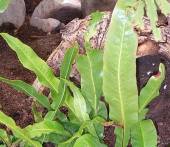
Microsorum pappei (Mett. ex Kuhn) Ching - Pappe's wart fern
The species is named after K.W.L. Pappe, the first colonial botanist at the Cape. The species is rare throughout its distribution, occurring from Madagascar to Tanzania, Mozambique, Zimbabwe and South Africa. In South Africa it is known from only a very restricted area in the KwaZulu-Natal midlands occurring in upland, moist, evergreen forests at about 750 mm above sea level. See more info below.
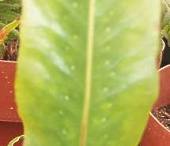
Microsorum pappei (Mett. ex Kuhn) Ching - Pappe's wart fern
Microsorum pappei has a widely creeping rhizome up to 3 mm in diameter with fronds spaced about 30 mm apart. The leaf stalk grows up to 120 mm long, and the glabrous, simple, narrowly elliptic lamina is up to 370 x 80 mm. The circular sori are 1.5 to 2.5 mm in diameter, and occur half-way between the midrib and the margin in one or two rows on either side of the costa.
The species is not available in the trade, but should it become available, it must be grown in light to deep shade in an environment with a high humidity. The species should be grown in a loose, well-drained medium that should always be kept moist.
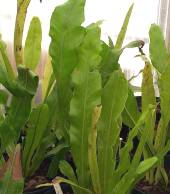
Microsorum punctatum (L.) Copel.-pitted wart fern
The specific epithet punctatum refers to the minutely pitted or dotted nature of the lamina.
Microsorum punctatum is widespread in the Old World, occurring from the Pacific islands, Malesia, tropical Asia and southern China to India , Madagascar and Africa. In Africa it occurs from West Africa through central to tropical East Africa to the east coast of South Africa as far south as Port St Johns. It is a predominantly low-altitude species occurring from near sea level to 1 500 m. The species rarely occurs on the ground, but more frequently in leaf litter and mosses on rocks in the forks of trees, often high above the ground. See more info below.
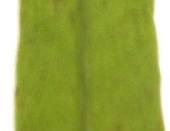
Microsorum punctatum (L.) Copel.-pitted wart fern
Microsorum punctatum has a short, creeping rhizome up to 4 mm in diameter and is covered with a thick felt of roots. The fronds are short-stalked and up to 10 mm apart. The narrowly elliptic lamina is simple, and up to 1500 x 110 mm. It has a thin leathery texture and is minutely pitted. The sori are about 1 mm in diameter and are irregularly scattered on the undersurface of the lamina.
The species is ideal for cultivation indoors and outdoors provided that it is planted in deep shade, never exposed to direct sunlight and kept moist at all times. An increased humidity will be beneficial. The species is best cultivated in a well-drained humus-rich medium kept moist at all times.
Uses: A tea of the plant is drunk for coughing fits. The leaf sap has also been reported to be used as an enema.
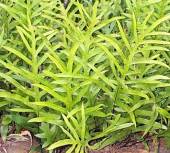
Microsorum scolopendria (Burm.f.) Copel.-embossed fern
The specific epithet scolopendria refers to the scalloped nature of the lamina.
Microsorum scolopendria , formerly known as Phymatodes scolopendria, is widespread in the Old World, occurring from Australia , throughout Polynesia and Asia and extending to Madagascar and Africa. In Africa it occurs from West Africa, throughout tropical Africa to the east coast of South Africa as far south as Port St Johns. In South Africa it mostly occurs in dune forests and dune scrub, near sea level. See more info below.
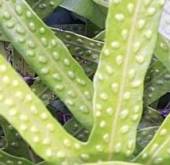
Microsorum scolopendria (Burm.f.) Copel.-embossed fern
Microsorum scolopendria has a widely creeping rhizome up to 10 mm in diameter that mostly occurs on the soil surface. The deeply pinnatifid, leathery fronds, up to 0.9 m long, are widely spaced along the rhizome. The stipe (leaf stalk) is up to 400 mm long. The leaf blade is divided into narrowly oblong lobes, up to 220 x 30 mm. The somewhat sunken sori are round to oval, 2 to 3 mm in diameter and occur in one or two rows on either side of the costa. Adaxially the sori are embossed.
This is a hardy species and easy to cultivate in a wide range of habitats. It is best cultivated outdoors in light shade, but it will also tolerate direct sunlight for part of the day. In older gardens it often establishes on brick or stone walls, or on trees, especially palms. Although it will tolerate short, dry spells it is best cultivated in conditions which remain constantly moist.
Uses: For abscesses, a paste of ground leaves mixed with earth from a wasp's nest is applied. For wounds, leaf pulp is used as a dressing, and for insanity, leaves are ground in water and the liquid drunk.
Credits
Koos Roux
Compton Herbarium Kirstenbosch
January 2005
Plant Attributes:
Plant Type: Fern
SA Distribution:
Soil type:
Flowering season:
PH:
Flower colour:
Aspect:
Gardening skill:
Special Features:
Horticultural zones






Rate this article
Article well written and informative
Rate this plant
Is this an interesting plant?
Login to add your Comment
Back to topNot registered yet? Click here to register.